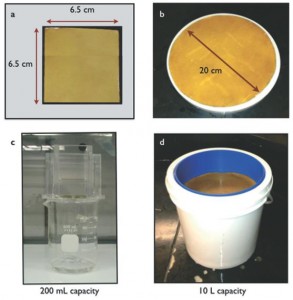Silver nanoparticles (AgNPs) are becoming increasingly popular due to their antimicrobial properties. In fact, silver compounds have been used to treat or prevent infections since before penicillin was ever discovered. The ability of AgNPs to kill microorganisms brings great potential for treating drinking water in situations when traditional water treatment is not possible.
Roughly 10% of the world’s population does not have access to safe, clean drinking water because basic sanitation is lacking. In some cases, a point-of-use (aka in-your-home) water treatment method that is easy and affordable might make a great difference in preventing or reducing the incidence of diseases caused by water-borne microbes, such as cholera and poliomyelitis. A water filter that is embedded with a small amount of AgNPs is a great example of a point-of-use treatment method that can be easily distributed to homes in developing countries and used with minimal training.
In this paper, T. Dankovich, from the University of Virginia, presents us an elegant method for creating paper filters that are embedded with silver nanoparticles. Her method can be considered more environmentally friendly than usual silver nanoparticle synthesis techniques because the reducing agent is glucose (that’s right, sugar!) and the heating technique involved nothing more than a domestic microwave oven (that’s right, a kitchen microwave!). In this technique, silver nanoparticles were synthesized directly on the paper filters, as opposed to being synthesized in a liquid suspension and then applied onto the filter. This method avoids the potential pitfall of nanoparticle aggregation during application onto the filter.
environmentally friendly than usual silver nanoparticle synthesis techniques because the reducing agent is glucose (that’s right, sugar!) and the heating technique involved nothing more than a domestic microwave oven (that’s right, a kitchen microwave!). In this technique, silver nanoparticles were synthesized directly on the paper filters, as opposed to being synthesized in a liquid suspension and then applied onto the filter. This method avoids the potential pitfall of nanoparticle aggregation during application onto the filter.
The paper filters were successful treating water containing two different types of bacteria (E. coli, and E. faecalis). Moving forward, it will be interesting to know the efficiency of this type of filter in treating real surface water samples and the filtering capacity, or how many liters of water each filter is capable of treating before it needs to be replaced.
To access the full article, download a copy for free* by clicking the link below.
Microwave-assisted incorporation of silver nanoparticles in paper for point-of-use water purification
DOI: 10.1039/c4en00067f
Theresa A. Dankovich
Liked this blog? Find out more about Marina in her first Environmental Science Nano blog on carbon nanotubes.
* Access is free through a registered RSC account – click here to register










